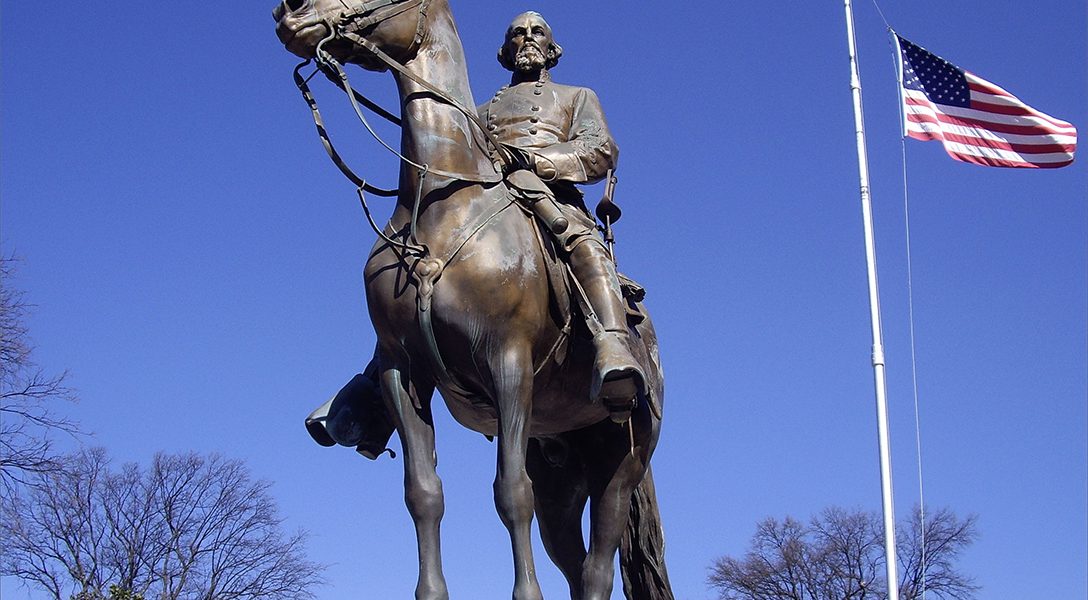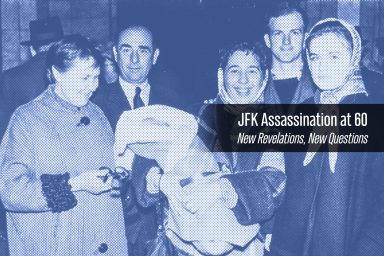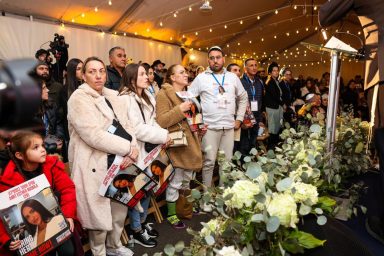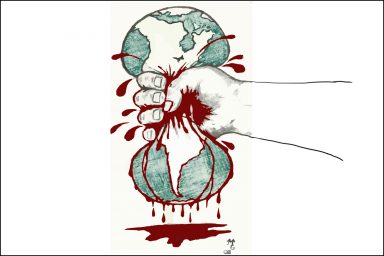Does the South really need controversial Confederate monuments in public squares to learn about the Civil War? Perhaps a trip to the museum is in order.
It is said that winners write history. In the case of the US Civil War it’s a bit more complicated. For the sake of uniting a divided country, the losers of the war have been allowed to cling to their own narrative of what happened — and that is once again causing problems now.
Wars come and go, and it’s typically the job of cloistered historians to debate their consequences. But the US Civil War remains an open wound. Debates about it cut deep to the roots of what George Washington called the nation’s “great experiment.” Its history is a perpetual reminder of America’s original sin.
Where museums often house the memorabilia of other wars, monuments to the Civil War have been permanently seated in public squares throughout the United States — and in particular the South. The overwhelming majority were installed following the collapse of postbellum Reconstruction in the late 19th century and during the rise of Jim Crow in the early 20th century. The American Civil War Museum provides one of the the best collections of resources about these monuments and what they represent.
In this WhoWhatWhy podcast, Jeff Schechtman talks with Christy Coleman, the chief executive officer of the American Civil War Museum. Coleman exposes the false simplicity that pervades so many of our conversations about the fratricidal bloodbath. She also explains that the materials schools use to teach about the war divide North from South and East from West, and shows why it remains so difficult to agree on a single set of facts.
She also talks about the important roles that museums might play, as this debate once again moves to center stage.
Click HERE to Download Mp3
Full Text Transcript:
As a service to our readers, we provide transcripts with our podcasts. We try to ensure that these transcripts do not include errors. However, due to a constraint of resources, we are not always able to proofread them as closely as we would like and hope that you will excuse any errors that slipped through.
| Jeff Schechtman: | Welcome to Radio WhoWhatWhy. I’m Jeff Schechtman. |
| Because memory is imperfect, because traditions and stories are often altered as they’re passed down from generation to generation, because history is factual but fluid, we often build statues or preserve buildings as kind of triggers to our remembered past. Normally, this is played out in community battles over preservation versus progress, but when the subject is the Civil War, everything seems to change. Perhaps that’s as it should be, as the Civil War was, after all, the penultimate flash point of America’s original sin. While other wars come and go, often left to cloistered historians to debate, the Civil War, slavery, and the fabric of the republic are re-litigated over and over and over again. And so it goes today in the battle over statues that some see as the embodiment of all that’s wrong. | |
| We’re going to talk about all of this and try and put it in some kind of perspective today with my guest, Christy Coleman. She is the chief executive officer of the American Civil War Museum. She grew up in Williamsburg, has a bachelor’s and master’s degree from Hampton University. She wrote the script for the Emmy-Award-winning film Freedom Bound. It is my pleasure to welcome Christy Coleman to the program. Christy, thanks so much for joining us. | |
| Christy Coleman: | Thank you so much for having me. |
| Jeff Schechtman: | First of all, tell us a little bit about the American Civil War Museum. What is it, and a little bit about its history. |
| Christy Coleman: | Certainly. The American Civil War Museum is actually relatively new. I say relatively new because we are the consolidation of two museums, the Museum of the Confederacy and the American Civil War Center at Historic Tredegar. Both institutions came together in 2013-2014 with a new mission to be not only the preeminent center for the study of the American Civil War, but to explore this war from multiple perspectives, Union, Confederacy, African-Americans, enslaved and free, immigrant communities, soldiers, civilians, and political issues. We really looked for experience and a variety of choices that are made from an individual level, community levels, political and national levels, experience from the military, the things that happened on the battlefields. That’s who we are. It’s a big, big chunk- |
| Jeff Schechtman: | Indeed. |
| Christy Coleman: | … but it is probably … Yeah, it’s a … I was going to say probably. There isn’t any other place where visitors can really get that level of breadth with the work that we do. |
| Jeff Schechtman: | Given that you have been doing this for a while, what do you see as really the fundamental misunderstanding that people have with respect to understanding the Civil War? |
| Christy Coleman: | The biggest problem has always been simplicity. The biggest problem has always been this idea of a binary reality in that the Union fought the war to end slavery, the Confederacy fought the war to maintain it. While there are grains of truth for that, the reality was so much more complex. When the war began, there were a number of issues at play. Some say it was about states’ rights. Some say it’s about tariffs, it’s about taxes, it’s about this, it’s about that. At the heart of even those issues was how are we going to manage slavery as it exists? Will we allow it to expand? That played out in really provocative ways for individuals whether they were slave holding or not. |
| The entire economy of the country, prior to the war, was dependent on some level or another on the bondage of over four million people. That’s one place that we have to start. The second thing is the Union, or the United States, which is what I prefer, the United States enters the war with the sole purpose of keeping this union together. That is their sole purpose. They are responding to actions by individuals in Charleston, South Carolina, who turn firing upon Fort Sumter. Right? From that moment on, it begins to transition, and everyone starts shifting. There are those who are advocating for an immediate peace. There was a naivete that this conflict would be over within a couple of weeks, couple of months at best. No one had any idea the scale and the scope of what this was about to bring on the nation as a whole. | |
| In the end, you end up with over … The recent estimations are really over 750,000 soldiers dead. You’ve got scores more, hundreds of thousands or more, who are permanently maimed or disabled. That also includes civilians. You have the outbreak of disease. We have no idea, for example, how many of those African-Americans that chose to self-emancipate during the course of the war ended up dying in contraband camps. We simply are still uncovering this data, but what is unmistakable is this was probably our nation’s most dramatic, deadliest, and most complex encounter. | |
| Jeff Schechtman: | How much of the complexity, and how much of the misunderstanding that is resulting in even the battles that we are fighting today, every day it seems, comes not only from the run-up to the war and the misunderstandings that you talk about, but from the failures of reconstruction, and what played out after the war? |
| Christy Coleman: | There’s no doubt that that also plays out. I correct people all the time. Reconstruction didn’t fail. Reconstruction was abandoned. It was slaughtered. Because of that, all of the gains, the social and political gains, that newly-freed people were making, the things that they legislated like free education for all, the things that they legislated about equal access to the ballots and property rights were immediately stripped away. When that happens, you’re right, there is a reassertion of white supremacy over the population, and this is tolerated, quite frankly, North and South. This is not just a Southern phenomenon. In fact, some of the most restrictive segregationist and Jim Crow policies would also actually develop in the United States. |
| I think what we’re seeing is that, regardless of what individual people did, what we’re seeing is people’s reaction to a conflict that we still can’t come to a consensus, quite frankly, about even the complexity of what happened. I mean it’s almost as if … I’ve used the analogy of quoting the Eastern philosophy about the blind men and the elephant. Everybody’s touching a part and swear they know exactly what it is and are not even remotely trying to have a conversation with the others around them who are touching other parts so that they can come up with what the picture really is, which is the elephant. | |
| Jeff Schechtman: | That really seems to be the direct line to where we are today when we look at so many of these statues, so much of this history that came out of that period after the abandonment, as you say, of reconstruction and, really, in the early 1900s, with the rise of Jim Crow, when so many of these statues and monuments were put up. |
| Christy Coleman: | Right, right. That’s exactly right. You can’t divorce what’s happening on the larger social scope from when the monuments go up. You can certainly acknowledge that many of these monuments are being placed as veterans of the war are dying, and so the earliest ones are, in fact, showing up in cemeteries, which is appropriate, right? |
| Christy Coleman: | But when they start showing up in the public square, they have a different meaning, inherently a different meaning for different folks. There are some who are trying to position this as if, oh well, people really understood, at the time, why they were going up. There were disagreements at the time. People were expressing outrage at the time that these were going up, predominantly communities of color, but there were also white Southerners, who had been Unionists during the course of the war, who found them an affront. |
| Again, they go up, legislatures, particularly across the South, start passing laws about when, where, and how, and don’t touch them, and this is what this is about, and this is what that’s about. It becomes this … Think about this. When you put a Confederate soldier at a courthouse, think about what that means for someone coming there for justice. Right? They do have power, and we can’t ignore the power that they have and that there are a variety of voices there. | |
| I can also appreciate how white Southerners desire to remember their loved ones who served and who sacrificed much, both in terms of life, limb, or property, or any of the other things. I can appreciate that to a certain degree but, again, you cannot divorce the times in which they are living, right? | |
| Jeff Schechtman: | Doesn’t that really call upon exactly the kind of institution that you have in the American Civil War Museum as a place, as a centerpiece for all of this, that all of this belongs in this kind of museum environment or even in things like, and I want to talk a little bit about Monument Avenue in Richmond, that belong in those places, as opposed to being part of the public square? |
| Christy Coleman: | Right. A lot of folks have said that, “Okay, so if you remove them, put them into museums.” Museums, we have artifacts. We have the documents. We have the archives. We have the letters and the diaries that, when you look at them in their totality, they give us a sense of what is happening. Whereas in a public square, it doesn’t have other things around it to provide the fuller context, and I think that’s the pushback that some people are expressing right now. So yes, I think that our institution has an important role to play in helping people understand that, and so when they do come into our spaces, they can learn about all of these individuals, both in terms of their personal feelings but also their public action and behavior. |
| Jeff Schechtman: | Talk a little bit about Monument Avenue. |
| Christy Coleman: | Monument Avenue started as a real estate development on the edge of town, the western edge of town. The desire was to build a grand boulevard, a grand egress similar to what one would find throughout Europe. Right? That was the idea. We have emerged from war. Our economy is starting to pick up. We are regaining our footing. We are moving forward. Right? The desire was to build this grand boulevard with grand houses along the way. They were originally thinking about archways and varying types of sculpture. |
| Well, when Robert E. Lee dies in 1870, there’s an immediate outcry to do something to honor the man that had come to mean Southern virtue far more than Jefferson Davis or any other figure, really. Lee, and then subsequently J.E.B. Stuart, Stonewall Jackson, those became the heroes. The military leaders became the heroes and the virtuous ones, and so when Lee died, there is a number of organizations that get together and say, “How shall we honor them?” | |
| The first thing that they recognize is that we have to put him in Richmond. Richmond was the former capital of the Confederacy. This is the place that he fought to defend for four years. It’s got to be Richmond. Then there was the question of where. When the real estate developers and the folks who wanted to do the honoring got together, they said, “This shall be the place. If we put the statue there, that will help drive not only the building of these homes, but it will also be the anchor. It will be the center of what we can do along this space.” And so that highly discourages, o ut and out says, “No. Don’t do this. Do not build these things. Let us rebuild and come together as a nation and as a union and let us put aside our bitters. Do not stick these things up because, inevitably, they will cause strife.” This is what he says in 1869. | |
| Either those words were not … Well, clearly, those words were not dealt with. Folks thought he was just being his normal, humble self. Nonetheless, it happened, and once the first one went up in 1890, the others soon followed. Monument Avenue became this, again, grand boulevard, and this showcase, and it did not take it long to be listed as one of the most beautiful streets and thoroughfares in the country. Then it became this place where you have million-dollar homes and plus, million-dollar-plus homes lining the boulevard. | |
| As this city and others whose voices, during the time those went up, were muted or silenced, you’re in a new age and a new time where people are reassessing what their meaning is. I think that, on some levels, having a dialogue about that is healthy, but what we’ve seen is, right now, the dialogue is difficult because people’s passions are leading the day at this moment. But it’ll come, and our institution is … We’re working with a number of partners, cultural, academic, community partners to try to, again, look at how can we help our community have this dialogue, have our nation have this dialogue? | |
| Jeff Schechtman: | One of the things that seems to be true, and I was talking to one of your colleagues about this yesterday, is that the pushback to all of this, what we’re experiencing now, seems to be of a cyclical nature. For a while, you don’t hear about it at all and then, all of a sudden, it really comes out in front. Talk a little bit about your thoughts on that. |
| Christy Coleman: | The truth is, I’m really still trying to process a lot of what’s happening recently myself, and so I’m not sure I can give you a cogent answer about that right at the moment. |
| Jeff Schechtman: | I mean there do seem to be things that trigger it. I mean even more than the events of the past week or so. I mean the current wave really seems to go back to the Dylann Roof incident in Charleston, and that’s really what kind of precipitated this wave that we seem to be in now. |
| Christy Coleman: | Again, this is not the first time. It’s almost been like a ripple effect, right? At various points in time, people have expressed their opposition to these things. It’s really about in public space, tax dollars for the care and feeding of these kinds of things, and so you have … Yes, there’s no doubt that the massacre that occurred in Charleston was a tipping point about raising the question about images. It just so happened, in that particular case, it was about flags, right? Battle flags. The fever pitch and the waves continued because, again, you can’t divorce a single act or a single action from the times. |
| There was, and has been, considerable concern about unequal justice, about the promise of America that’s not fulfilled for some. That anxiety, you begin to look for reasons for that. You’re looking at your landscapes, and you’re looking at your spaces, and you’re … All of that is happening, and I think … What I see in watching these patterns of behavior is also in a … It isn’t surprising when I keep my public historian hat on, because we have these pulses back and forth over time when there are great periods of progression towards equal rights and social justice. | |
| As that marches forward, and especially if it seems to be marching rapidly, there is always pushback, very hard pushback to that in the subsequent years. It’s like a 25-year cycle, and then you get four or five years of harsh pushback against those social gains and progress, and then you go back into periods of progression. A lot of it is around the idea that, somehow, by expanding these rights or really looking at our systems and their shortcomings that somehow somebody’s going to lose something. It never is a zero-sum game, and it’s never binary. | |
| Jeff Schechtman: | The other part of it, in thinking about this, is that, unlike so many other historical things that kids learn in school, that the teaching of the Civil War, that the understanding of the Civil War is so fundamentally different in terms of the way it’s taught in the North versus the South. |
| Christy Coleman: | That’s right. That’s right, and that’s by design. You start seeing, again, coming out of the reconstruction, especially now that we’re talking about public education at the turn of the century, that there are very ardent voices that are saying, “Why would we let our enemy teach us about our past?” In the South, particularly women, rallied with educators, and they started producing their own text books that told a very, very different story. It was a very different way of approaching it. That permeated, and that’s why you have this very different understanding of the narrative, North and South, East and West, quite frankly. It was deliberate. |
| If I’m not mistaken, and I would have to … before I make the statement, but I believe that there may be a couple of states that still have a requirement of … I know that, at one point, Virginia had this. I think Texas had it. Again, whether it’s still in effect, I’m not certain, but where a representative from the United Daughters of the Confederacy always served on state education committees to make sure that the textbooks reflected the history the way they wanted it told. | |
| Jeff Schechtman: | Finally, talk about what you see as the job, the responsibility, however you want to put it, of a place like the museum, the American Civil War Museum, the responsibility of it in a time like this where it’s so important that people understand real history. |
| Christy Coleman: | Yeah. Well, again, for us, the opportunity is to bring folks with either little to no knowledge about, or folks who have self-curated their content, to come face to face with information, artifacts, again, letters, diaries, what have you, that help them expand their knowledge. Museums generally, and this is according to the Pew Charitable Trusts, this isn’t Christy Coleman making a statement here, but museums are, in fact, the second-most-trusted institution for learning about history and culture behind libraries. |
| That’s important. That is a responsibility. That is a social responsibility that we have, to provide spaces for communities to explore who and what they are and what they value. I take that charge extremely seriously to provide that space. I will go where the research leads us and where the scholarship leads us, and so that also requires ongoing work and conversations with scholars and opening up the materials that we have, for example, in our archives and others to help advance that. | |
| Jeff Schechtman: | Christy Coleman, she’s the chief executive officer of the American Civil War Museum. Christy, I thank you so much for spending time with us here on Radio WhoWhatWhy. |
| Christy Coleman: | Thank you so much for having me. Again, we will keep ourselves close, and watch, and work together to come up with the solutions that our communities need. |
| Jeff Schechtman: | Christy Coleman, thank you so much. |
| Christy Coleman: | Thank you. |
| Jeff Schechtman: | Thank you for listening and joining us here on Radio WhoWhatWhy. I hope you join us next week for another Radio WhoWhatWhy podcast. I’m Jeff Schechtman. If you like this podcast, please feel free to share and help others find it by rating and reviewing it on iTunes. You can also support this podcast and all the work we do by going to WhoWhatWhy.org/donate. |
Related front page panorama photo credit: Adapted by WhoWhatWhy from Christy Coleman (NEH), American Civil War Museum (Ted Eytan / Flickr – CC BY-SA 2.0) and Statue of Nathan Bedford Forrest (Ron Cogswell / Flickr – CC BY 2.0).





